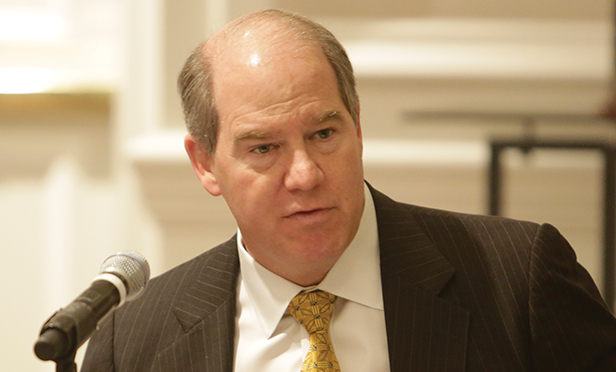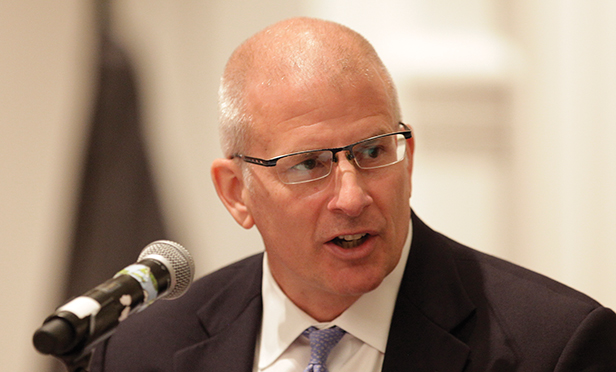 Participating in the Real Estate Forum/Transwestern Institutional Investor Symposium are (clockwise, from top left) Joe Miller, Northwestern Mutual Real Estate; Carrie DeWees, Allstate; Scott Kempton, TIAA Global Asset Management; Jim Street, PGM Real Estate; Jim Halliwell, Principal Real Estate Investors; Dirk Mosis, USAA Real Estate Co.; Michael Desiato, ALM’s Real Estate Media Group; and Steve Pumper, Transwestern. PHOTO CREDIT: Chris Kleponis
Participating in the Real Estate Forum/Transwestern Institutional Investor Symposium are (clockwise, from top left) Joe Miller, Northwestern Mutual Real Estate; Carrie DeWees, Allstate; Scott Kempton, TIAA Global Asset Management; Jim Street, PGM Real Estate; Jim Halliwell, Principal Real Estate Investors; Dirk Mosis, USAA Real Estate Co.; Michael Desiato, ALM’s Real Estate Media Group; and Steve Pumper, Transwestern. PHOTO CREDIT: Chris Kleponis
This is an HTML version of an article that ran in Real Estate Forum. To see the story in its original format, click here.
It’s a tough world out there. Velocity in investment sales is dropping off, performance metrics are receiving mixed forecasts, tightened scrutiny by lenders is making capital harder to obtain and uncertainty in the domestic and global markets is putting decision making on hold. It’s into this environment that institutional players must place massive sums of capital to meet their real estate allocations.
And they are on track to meet their goals, according to the pros that participated in Real Estate Forum/Transwestern’s Annual Institutional Roundtable, held recently at the Ritz-Carlton in Washington, DC. While these players are, rightly, confident in their strategies and ability to transact, they’re also a bit warier than they were last year—particularly about that unknown “X” factor they say could send this precarious market into a spin.
PARTICIPANTS
Michael Desiato (moderator) is vice president and group publisher of ALM’s Real Estate Media Group in New York City.
Carrie DeWees is a portfolio manager for Allstate, based in Chicago. *DeWees’ comments have been omitted from the Roundtable because the firm could not verify the content in time for REF’s press deadline.
Jim Halliwell is a managing director with Principal Real Estate Investors, the real estate investment arm of the Principal Financial Group. He oversees private equity for the Des Moines-based group, which has approximately $67 billion of assets under management, covering public, private, debt and equity investments.
Based in New York City, Scott Kempton is a managing director in the real estate investment business of TIAA Global Asset Management. The company has $96 billion in real estate assets under management, consisting mostly of private equity and and private debt. The firm has also introduced a new global real assets division which offers agriculture, timber, infrastructure, energy and private debt investments.
Joe Miller, principal, handles all mortgage production in the Eastern US for Northwestern Mutual Real Estate. Debt accounts for some $42 billion of the Milwaukee-based firm’s $40 billion in real estate assets under management.
Executive managing director Dirk Mosis oversees USAA Real Estate Co.’s office development program and value-add investments. The San Antonio, TX-based firm has $16 billion in real estate assets under management.
Steve Pumper (moderator) is executive managing partner, capital markets and asset strategies, for Transwestern in Dallas.
Jim Street is with PGM Real Estate, formerly known as Prudential Real Estate Investors, the real estate arm of PGIM. The Atlanta-based executive director oversees dispositions for the firm’s US equity funds, which account for approximately $40 billion of an overall $65.4 billion in global real estate assets under management.
— — — — —
STEVE PUMPER: The pace and volume of sales have come down as compared to last year as entity-level and portfolio deals have declined in prevalence. Are we getting later into the cycle, or are investors taking a “time out”?
JIM STREET: The question we ask internally is whether we’re just in a rain delay or the game has ended and the players just don’t know it. I think it’s more like a rain delay. Velocity has definitely slowed and the bid-ask spread has increased a bit. But we’re still committing to acquisitions at a healthy pace. What’s most comforting is we’re forecasting reasonably healthy NOI growth across all of our assets for 2016, so from an operational standpoint, our properties are not struggling. Things are slowing and tenants are taking a bit longer to make leasing decisions but overall, it’s pretty healthy.
JOE MILLER: We got off to a fast start on the debt side this year and our appetite has not waned. Clearly transaction volume has declined, though I can’t opine as to why. Perhaps people are just simply putting off decisions given the uncertainty and volatility in the capital markets. As it relates to the economic cycle, I feel as though we’re in the later innings. However, I think the Fed will be measured and not raise rates aggressively.
 “Now is the time to take advantage of conditions and cull your portfolio, improve the overall asset quality and get out of markets you don’t want to be in, just in case there’s a storm coming.”—Scott Kempton, TIAA Global Asset Management
“Now is the time to take advantage of conditions and cull your portfolio, improve the overall asset quality and get out of markets you don’t want to be in, just in case there’s a storm coming.”—Scott Kempton, TIAA Global Asset Management
MICHAEL DESIATO: Speaking of office, Dirk, you’ve been active there, particularly with development. How has that been working out?
DIRK MOSIS: Right now, we have about $2 billion in office product in various stages of the development cycle; we’re developing about 16 of them with about a dozen developers. For the past few months, we’ve been stretched to do anything with a spec component. It just doesn’t feel right. Having said that, we’ve just closed two spec deals in San Jose, CA and Chicago. But every market is different. We aren’t seeing a lot of tenant activity across the board. We don’t want to deliver into what we expect will be a recessionary time and take two or three years to lease something up.
To the rest of the panel, if you’re actively developing, do you test it with construction lenders? We’re hearing that the construction lenders are becoming more conservative. There is a lack of high numbers of lenders that want to lend, and then they come to us for backstops, which is not really part of our [USAA Real Estate Co.’s] pro forma. We credit the banks for trying to figure this out ahead of us, thinking that they must be seeing something. There aren’t too many spec deals that are secured lending, so they [the banks] really get pushback from the regulators. They look at it, but they’re not serious.
JIM HALLIWELL: If you look at the normal return distribution curve, I think we are past the peak point of returns. For year to date 2016, annualized returns for the NCREIF index are in the single digits following six calendar years of double-digit returns. Given this recent decline it is natural to expect some lessening of demand into the sector. Investors can be fickle; they like to pile on when returns are high and may elect to exit when returns dissipate. On an operational level, given that occupancies in most product types are near historic highs, how much better can occupancy get? So, some may question how much higher real estate can go.
The trick is calling the right markets. If you invested all your capital in DC the past few years, you were less than satisfied as this market has trailed the index. If you invested in San Francisco or in super regional malls, you were quite happy. So it’s becoming much more important to do the research and pick the right locations and pick the right categories, because some of them still have runway. On a macro basis, however, the runway is shorter than it used to be.
I think the asset class is going to revert to the norm with the majority of return attribution coming from income rather than appreciation. In our opportunity funds, we do need to generate alpha and get some higher-level returns, but we will be selective in higher-risk activities such as development. Right now, multifamily may be in the later innings, and it’s trailed the index of late. So, we have placed greater emphasis on industrial and necessity retail.
 “While a dwindling CMBS market may present some opportunities, there is a fairly deep market of other debt and equity sources at a reasonable cost to navigate such a decline.”—Jim Halliwell, Principal Real Estate Investors
“While a dwindling CMBS market may present some opportunities, there is a fairly deep market of other debt and equity sources at a reasonable cost to navigate such a decline.”—Jim Halliwell, Principal Real Estate Investors
SCOTT KEMPTON: On the retail side, there’s been a slowdown in sales, as everybody knows. On the regional mall front, we’ve seen tourism sales decline. The recent sales decline Macy’s department stores have experienced is primarily due to the lack of spending in the tourist-based markets. Tourists are still coming to the US but are spending less because of the strong dollar and global economic concerns. Consumer confidence in the US has waned, too, because of global economic concerns and the lack of wage growth.
Our view is that the current recovery has been very slow and measured. Therefore, if you look at the runway in terms of overall expansion, we’re maybe only in the fourth or fifth inning. There’s no real foreseeable economic shock hanging out there right now and the fundamentals are good. When you look at the market, you have to ask not whether it’s overheated, but whether it’s rational. Right now, pricing is rational and fundamentals are stable. There’s more than a 250-basis-point spread between the 10-year Treasury and cap rates. Occupancies are high. Construction lending is getting a little more curtailed, which is good. So unless there’s an unexpected shock that ends the expansion, right now it’s steady as she goes, for the next 12-18 months.
PUMPER: Based on everything you all have said, for 2016, will you be net sellers or net buyers?
HALLIWELL: We generally try to be as equal as possible. Given conditions, we may do more selling than buying, but not a lot more.
MILLER: Our allocation to real estate equity has increased. I’m sure we will recycle capital through select dispositions, but we will be net buyers. It may not feel very good because yields are skinny, but if you contemplate the alternative investments, real estate is still a good alternative.
KEMPTON: This year, we’ll be a net buyer for sure. Over the past several years, we’ve been averaging $2 billion to $3 billion a year in sales, and more than $5 billion a year in acquisitions. We’ve been fortunate in having a lot of net inflow and new clients and raising a lot of third-party capital. That’s part of it. For TIAA’s General Account, it’s been more even between buying and selling activity. Now is the time, though, to take advantage of conditions and cull your portfolio, improve the overall asset quality and get out of markets you don’t want to be in, just in case there’s a storm coming.
Though we have a wide variety of sector-specific sleeves of money to invest, we’re focused on a “cities strategy”—that is, buying in targeted markets that, over time and based on research, outperform those with a solid economy, where you can get steady NOI growth, and that have size and liquidity. We’re a big believer in core, target markets.
 “While fund managers often like to see higher production numbers on the disposition side, the market’s been more selective and the process on a property-by-property basis is taking longer.” —Jim Street, PGM Real Estate
“While fund managers often like to see higher production numbers on the disposition side, the market’s been more selective and the process on a property-by-property basis is taking longer.” —Jim Street, PGM Real Estate
STREET: In 2012-2014, we were a net buyer, generating an acquisition pipeline of about $5 billion a year, including our JV developments, as compared to an average annual disposition volume of approximately $3 billion. Last year, we were pretty even on acquisitions and dispositions with about $6 billion in each category. Maybe this was the peak of the cycle, but the reason we were able to hit that mark on the disposition side is because we had a couple of large-scale transactions that definitely impacted the numbers.
Looking at our year-to-date acquisition and disposition results, we’ll likely be down but roughly equal on both sides. We’re not consciously setting out to be absolutely balanced. We’re just being more selective with our acquisitions and development opportunities.
On the disposition side, it has been an interesting process this year. At the beginning of 2016, we asked our fund managers to identify the lowest performers to see if those represented disposition opportunities. So far, it’s been hit or miss on those opportunities, due to tentative conditions in the market. While fund managers often like to see higher production numbers on the disposition side, the market’s been more selective and the process on a property-by-property basis is taking longer.
MOSIS: We’ve been net sellers for the past couple of years, and will probably do so again this year. I think the gap may narrow, though. There are a couple of bigger portfolios out there that may swing it the other way. We don’t go in at the beginning of the year thinking one way or the other. We have goals in what we’re trying to do for our investors. We’ve spent quite a bit of time the past two years culling assets we’ve had a long time, or those that are underperforming or in tertiary markets. We’re not hoarding cash, but we’re very circumspect on committing big chunks of capital to development because we think that in the shorter term, there should be some buying opportunities. Not fire sales, but there will be some opportunities.
DESIATO: Debt maturities this year and next total about $204 billion. On the CMBS special servicing side, if you put in a 10% percent number on deals that transfer back in, that puts you at about $20 billion in terms of average loan size, which may be perceived a little bit high. But even at $15 billion, that’s a lot of real estate, so there will be opportunities.
Last year’s CMBS volume was roughly $100 billion, and it’s projected that CMBS will end the year with roughly $50 billion in volume. That’s half the amount of the prior year. It’s having an impact in that CMBS debt won’t be there to take out some of these players when the maturities come around. Is that playing into your strategies in any way?
MOSIS: That’s part of what we’re seeing and there are opportunities in distress. They are good properties, it’s just that they haven’t been leased up or they don’t have the capital to get leased the rest of the way. That’s what we’re trying to get ready for.
HALLIWELL: We have strategies in place to fill the void on higher leverage transactions in the absence of a robust CMBS market. We have subordinate financing platforms such as mezz debt and preferred equity. However, if you talk to our mezz group, they’d say subordinate financing is also getting to be a crowded field. There are a lot of debt funds, a lot of groups like us that participate in the sector via funds and separate accounts. On our equity side, we have contemplated using higher leverage in certain instances because the cost of debt is relatively low throughout the capital stack. The cost of equity capital has also come down as the JV equity terms are more distasteful than I’d like them to be. So, while a dwindling CMBS market may present some opportunities, there is a fairly deep market of other debt and equity sources at a reasonable cost to navigate such a decline.
KEMPTON: I wouldn’t disagree with that. We’re investing in mezz loans and B-notes, predominately on the back end of the larger single-asset CMBS deals.. We’re also raising money against high-yield debt strategies. We have such a large, well established debt platform that it’s a natural outreach for what we do. Foreign capital particularly likes the higher yielding debt space so we’ve been expanding our debt platform to cater to client priorities.
 “I tell my team consistently, let’s be sure we’re not taking equity risk in the mortgage portfolio, because we certainly are not getting paid for it.” —Joe Miller, Northwestern Mutual Real Estate
“I tell my team consistently, let’s be sure we’re not taking equity risk in the mortgage portfolio, because we certainly are not getting paid for it.” —Joe Miller, Northwestern Mutual Real Estate
PUMPER: When we were out in the market earlier this year, we heard a lot of folks say that you need to get your debt capital the first half of the year, because things might start to slow in the second half, as a lot of the debt might be already placed and people might hit their bogey for the year. What are you seeing? Did you hit your numbers for the year or do you have plenty to place in the second half? How about your competitors?
MILLER: I’ll add some color to that. Our goal this year is to originate about $5 billion in commercial mortgages. We got off to a fast start, as did many of our peers. Capital will continue to be available, it’s just a matter of at what price. If we can provide relative value, we will have an appetite, and I think our peers will as well.
DESIATO: Some of you brought up foreign capital and many of you here have foreign partners. How is the inflow from international investors impacting you, in terms of either JVing with them, fund managing them, investment managing them, or just competing against them in the markets?
STREET: From the disposition side, I haven’t seen a big difference. About 10% to 15% of our sales every year involve offshore capital on the buyer’s side. It really hasn’t changed much year over year. I thought we would see an increase with the change in FIRPTA. Maybe it’s a bit slow to come or maybe it’s just that we don’t have the right properties on the market. There hasn’t been a dramatic change.
KEMPTON: It’s been interesting with the FIRPTA issue. The FIRPTA legislation change was announced, but the IRS has not given a ruling or a guidance brief on it. Effectively, they said, “You read it and you figure out what it means.” So in raising capital, all of our structures with non-domestic capital right now still employ domestically controlled REIT status, matching domestic capital with foreign capital. Approximately half our non-domestic clients believe they absolutely qualify under the new FIRPTA rules, but we still match their capital with domestic capital, just in case.
That’s a real positive in the legislation and one that could actually be a boon for us eventually. Domestic investors may not like it, but eventually there will be guidance. I think the intent of the regulations is clear enough—to exempt foreign pension funds from paying capital gains taxes. If that comes to fruition and investors get comfortable with it, it should lead to a huge increase of foreign capital coming into the US. The challenge has always been matching the domestic capital with the foreign capital and, right now, if you can offer a domestically controlled REIT structure, that’s what international investors want to see.
 “We all feel an angst over the equilibrium. The lack of confidence and the employment and wage issues in this country are all keeping people from making decisions.” —Dirk Mosis, USAA Real Estate Co.
“We all feel an angst over the equilibrium. The lack of confidence and the employment and wage issues in this country are all keeping people from making decisions.” —Dirk Mosis, USAA Real Estate Co.
PUMPER: As always, we will wrap this discussion up by asking all of you what keeps you up at night? Things feel pretty good, but there also also some valid concerns out there.
MILLER: Risk is truly priced to perfection right now and it’s hard not to be concerned about that. What I tell my team consistently is, let’s be sure we’re not taking equity risk in the mortgage portfolio, because we certainly are not getting paid for it.
STREET: The impact of Brexit will be interesting, in terms of disruption in the capital markets. Will that lead to an increase in redemption requests by investors? Will it lead to opportunities? We’ll see how it plays out.
KEMPTON: What worries me is the unknown. Fundamentally things are balanced, pricing is rational, there’s been long-term slow growth and the Fed is standing steady with rates. From a US economic viewpoint, it seems all is well and fine with the world. What is that shock that’s going to change that? Is it Brexit? China? Do we cause the shock ourselves through the election process? There’s nothing that stands out as the “X” factor. But hindsight’s 20/20 and someday we’ll be able to pinpoint what that X factor was.
HALLIWELL: What really amazes me, when I talk to some of the corporate clients and even some in the private sector, is the speeds at which they can sector rotate. They can rotate back and forth from public and private, debt and equity, and outside our sector. This provides some level of concern as the private real estate sector can fall out of favor faster than many think. One week you can be on top of the world and the next week, people aren’t returning your calls.
MOSIS: We all feel an angst over the equilibrium. The lack of confidence and the employment and wage issues in this country are all keeping people from making decisions. I just think there’s something out there that’s going to trip this thing. It’s always about jobs to me, and I don’t see any discussion on a federal level about what is going to be done on that front. They spend more time on regulatory issues like Dodd-Frank, and so in our company the best and brightest spend 90% of their time on regulatory issues when they could be using their time to think of ways to turn capital. That’s hugely bothersome to me. And if it bothers me, I know it’s got to bother a whole lot of others, too. The US is already more transparent than anybody else in the world, and trying to make ourselves more so. But at the same time, we’re taking away the creativity of our best and brightest.

















 Copyright © 2024 ALM Global, LLC. All Rights Reserved.
Copyright © 2024 ALM Global, LLC. All Rights Reserved.